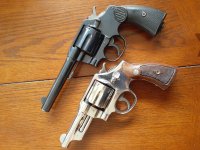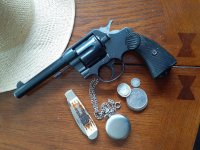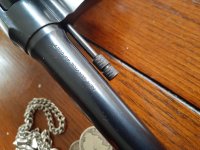sigp220.45
US Veteran
I love Colt New Services. It may be sacrilege here, but there is just something about this oversized sixgun - built during a time when a guy reaching 5'10" was tall - with no ejector rod shroud, no front lock up, no pinned barrel, and no recessed chambers that appeals to me. Especially in God's caliber, the .45 Colt.
A 7 1/2" New Service was the first gun I ever pointed in someone's face in self-defense. No skulls were exploded, but I'll always remember one of the responding cops holding that big Colt next to his holstered Model 10 and saying: Jeez kid, good thing you didn't pull the trigger or we'd be looking across the street for his head.
Anyway, I recently found this old warrior. 5 1/2" .45 Colt, circa 1921.


The good thing was it was only $32.95!

OK, not really. They originally wanted $1100, but I shrewdly pointed out the cylinder had British proofmarks meaning it was a replacement and had been rechambered from .455 to God's caliber by some oaf. The price dropped $300 and it was mine.

That Brit cylinder really bugged me, even though it shot fine. eBay to the rescue. A proper cylinder, unmarred by Royal proofmarks, came my way. Despite protestations from all that it wouldn't drop right in and I would need a Keebler elf with shirt garters and a green eye shade to fit it, it dropped right in. Even the finish matched.



It shoots great. I like to think some of its finish issues come from salty tears dripped on it by a grizzled upstate Trooper handing it in for a wimpy .38 Official Police.
A 7 1/2" New Service was the first gun I ever pointed in someone's face in self-defense. No skulls were exploded, but I'll always remember one of the responding cops holding that big Colt next to his holstered Model 10 and saying: Jeez kid, good thing you didn't pull the trigger or we'd be looking across the street for his head.
Anyway, I recently found this old warrior. 5 1/2" .45 Colt, circa 1921.


The good thing was it was only $32.95!

OK, not really. They originally wanted $1100, but I shrewdly pointed out the cylinder had British proofmarks meaning it was a replacement and had been rechambered from .455 to God's caliber by some oaf. The price dropped $300 and it was mine.

That Brit cylinder really bugged me, even though it shot fine. eBay to the rescue. A proper cylinder, unmarred by Royal proofmarks, came my way. Despite protestations from all that it wouldn't drop right in and I would need a Keebler elf with shirt garters and a green eye shade to fit it, it dropped right in. Even the finish matched.



It shoots great. I like to think some of its finish issues come from salty tears dripped on it by a grizzled upstate Trooper handing it in for a wimpy .38 Official Police.
Last edited:





